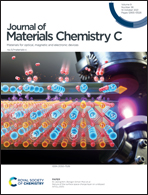Nature of the surface space charge layer on undoped SrTiO3 (001)†
Abstract
SrTiO3, an ABO3-type perovskite structure, has been a popular choice of substrate for many important heterostructures, e.g., ferroelectric thin films and superlattices. As numerous exotic physical phenomena are closely related to delicate electron/ion exchanges at the interfacial layer between the substrate and overlayer, precise characterization of surface/interfacial properties has become the center of many research studies. In most cases of SrTiO3 research, Nb-doping is applied on the SrTiO3 surface in order to characterize electrical properties with a negligible effect of contact potential between SrTiO3 and overlayer. On the other hand, the presence of doping can possibly interfere with a correct interpretation of the surface defect states, which become critical to apprehend the electrical properties of heterostructures. In this report, the undoped SrTiO3 (001) surface is investigated utilizing ambient-pressure XPS (AP-XPS) and low energy electron diffraction (LEED). We identified the complete chemical/structural/electronic states of O and Sr vacancies on the undoped SrTiO3 surface from ultra-high vacuum (UHV, <10−9 mbar) to O2 gas pressure of 0.1 mbar conditions. Under oxygen pressure conditions, chemically stable SrO1+x surface oxide with a c(6 × 2) superstructure is formed, generating electron depletion and band bending, i.e., the formation of a space charge layer underneath the surface. On the other hand, under UHV, the surface oxide comes from the O vacancy, which has different electronic properties from those of Sr vacancy-related oxides.

- This article is part of the themed collection: Journal of Materials Chemistry C Lunar New Year collection 2022


 Please wait while we load your content...
Please wait while we load your content...